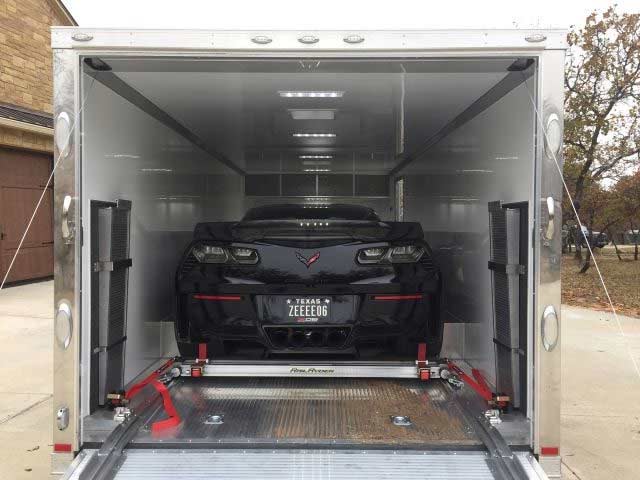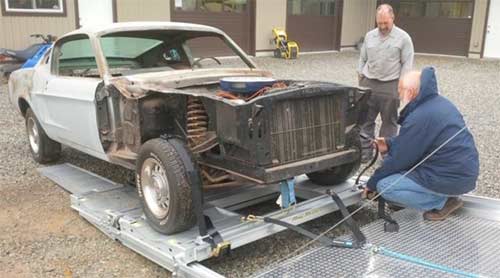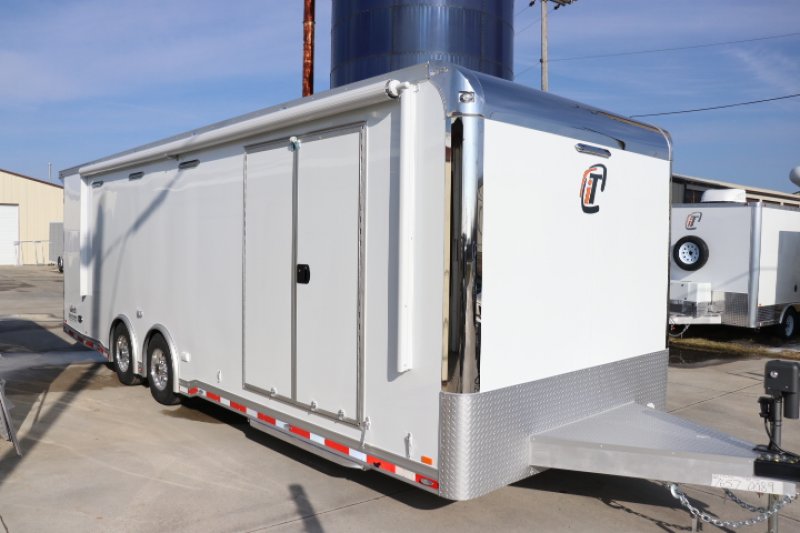If you are a car enthusiast, chances are that you will haul your precious cargo somewhere on a trailer. For instance, you may want to bring your racer to a track or transport your pristine collectible to a vintage car showcase. Sadly, the day will come where you must take your broken machine to a shop. In any case, owning (or having access to) a car hauler is crucial to maintaining your motoring hobby.
Of course, the type of car hauler you choose depends on the car(s) you own. For example, a specially designed exotic car hauler or custom enclosed trailer is ideal for your expensive supercar. If you have the cash, you can find an assortment of self-loading trailers at the top of the line. While the designs may seem limitless, there are a handful of critical questions that must be addressed, regardless of what type of trailer you have.
How should the load be set?
Before every haul, precautions must be taken to ensure safety. First, make sure you load the trailer on flat ground rather than an inclined driveway or any slanted stretch of road. Working on flat ground will not only save you time by make loading easier but will also reduce the risk of an accident from a runaway car. Also, make sure the trailer and tow vehicle are connected in straight alignment.
 Next, inspect everything from the hitch connection to the trailer track system. The trailer needs to be secured to the tow vehicle before loading to maintain stability. Make sure the truck’s parking brake is on, all connections are tight, and the trailer’s wheels are chocked. Finally, examine all connection sites. Damaged or loosened straps, rings, and tracks can fail and create a dangerous situation, especially while the trailer is in motion.
Next, inspect everything from the hitch connection to the trailer track system. The trailer needs to be secured to the tow vehicle before loading to maintain stability. Make sure the truck’s parking brake is on, all connections are tight, and the trailer’s wheels are chocked. Finally, examine all connection sites. Damaged or loosened straps, rings, and tracks can fail and create a dangerous situation, especially while the trailer is in motion.
Where should you put the weight?
The mechanics of a truck and trailer connection can create a teetering effect if the weight is off balance. Excessive pressure over the front of the trailer pushes down on the towing vehicle’s rear axle, which can reduce the weight on the front axle and make steering and braking difficult. If the weight is too far back, the truck’s rear axle could lift, creating instability. 10% of the trailer’s gross weight needs to be transferred on to the tow vehicle’s rear axle.
If you are hauling a front-engine car, do not back it onto the trailer. Most of a vehicle’s weight is typically around the engine, so a forward approach will make the placement much more manageable. You should, however, back in a rear or mid-engine car for the same purpose. Also, load the car very slowly. A gradual approach will ensure your vehicle is centered between the trailer’s inner fenders and in straight alignment. Carefully measuring and installing a trailer track system beforehand can guide your approach. Otherwise, marking out the “track” can help, especially if this is your first time.
How do you secure the car?
Tying down your car with ratchet straps is the final – and most critical – step before heading on your way. There are two primary systems to consider – axle straps and tire straps. Tire straps are recommended if you are hauling a modern vehicle because axle straps can damage newer cars. If you are carrying a larger vehicle like an off-roader, or a classic car, use axle straps. Tire straps likely will not fit on the bulkier tires of a larger vehicle.
Before you strap the car down, make sure the vehicle is in Park with the parking brake engaged. Attach the straps to the tires or axles, then fasten the clasps to the trailer’s d-rings. These are rounded, d-shaped rings typically located near each corner of the bed. If you have a parallel e-track system, you can buckle the d-rings where you want along each track. Once the straps are in place, use each strap’s ratchet to tighten until there is no slack.
What if the car you are loading does not run?
 If you need to haul a disabled vehicle, winching will be the easiest and safest way. An electric winch is a compact machine designed to pull tremendous weight from a stationary position. Plus, you can mount a winch to just about any type of car hauler, making it a vital tool for any automotive enthusiast. Just be sure to install your winch onto the front frame of the trailer, or else it can dislodge when pulling the car. If the chassis is inaccessible, a professionally installed winch mount may be needed.
If you need to haul a disabled vehicle, winching will be the easiest and safest way. An electric winch is a compact machine designed to pull tremendous weight from a stationary position. Plus, you can mount a winch to just about any type of car hauler, making it a vital tool for any automotive enthusiast. Just be sure to install your winch onto the front frame of the trailer, or else it can dislodge when pulling the car. If the chassis is inaccessible, a professionally installed winch mount may be needed.
Before using the winch, make sure the tow vehicle, trailer, and load vehicle are all on level ground, and in straight alignment. This will make the process easier and safer. Next, pull the winching cable out to the load vehicle and fasten it securely to the car’s designated towing point. Do not clip the cable back to itself like a noose, or else the cable can quickly fray and snap. Finally, put the load vehicle in neutral and winch away using the remote control.





